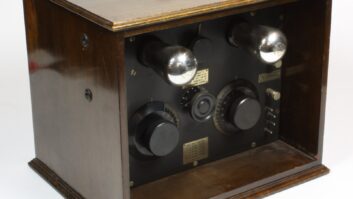
Consumer demand for one-to-one digital audio is a powerful economic force in the 21st century. Depending on your perspective, radio companies are either embracing the trend or being forced to do so. Either way, companies continue to diversify in the burgeoning audio marketplace.
The ongoing digital transformation is redefining how audio gets consumed in the home, the car and elsewhere, as Americans turn more often to their smartphones, tablets and connected speakers for audio content.
Observers who spoke to Radio World say all signs continue to point to continued growth of podcasts and on-demand content as personalized media plays a larger role in this overall audio ecosystem.
[Related: “So, Where Do We Go From Here?”]
The dramatic pivot in audio delivery is of critical interest to radio entities that engage consumers in the increasingly cluttered media environment. It leaves C-suiters searching for the latest accoutrement to accent their digital audio catalogs.
The trend is reflected in how “radio” companies now describe themselves.
Cumulus promotes itself as an “audio-first media company” that has broadcast, digital, mobile and voice activated options, including the Westwood One Podcast Network. SiriusXM — which owns Pandora and Stitcher and has an investment in SoundCloud — calls itself “North America’s leading audio entertainment company.”
iHeartMedia would probably contest that, given that iHeart lays claim to being “the number one audio company in the United States, reaching nine out of 10 Americans every month,” with a quarter of a billion monthly listeners, “a greater reach than any other media company in the U.S.”
CEO Bob Pittman has pushed the company toward new audio offerings.
“Podcasting is wide open and the sky is the limit. It’s sort of an on-demand version of radio. We see it as an extension of radio,” Pittman said during a quarterly earnings report in 2020. Just this month the company announced another planned audio-related acquisition, that of Triton Digital.
The podcast business is thriving, with growth driven by consumers embracing on-demand audio; and radio firms have participated. Research from Borrell & Associates and the RAB shows that over 70% of radio stations produce locally-focused podcasts.
Entercom is another company emphasizing the power of audio. It released a study at the virtual CES 2021 show showing that the nature of audio content makes it more engaging for audiences than other media. The study tracked “immersion,” defined as “a scientific measure of emotional connection and attention,” and found that audio ranked highest in the test.
The proliferation of audio seems to be pushing radio broadcasters to adopt mobile apps and tech innovation to further their reach. And those efforts are expected to accelerate as hybrid radio in connected cars and voice activation tools like Amazon’s Alexa Auto proliferate. Understanding the “skills” required to integrate with new audio services will be critical for radio broadcasters, experts say.
“Every channel matters”
Jeremy Sinon, VP of digital strategy for Hubbard Radio, said the company is quickly moving to digital, as in its partnership with PodcastOne in the on-demand space.
“We have a strong focus on our mobile apps, web listening and smart speaker listening. We also continue to focus on consumption via video on platforms like YouTube, Facebook and Instagram. Every channel matters and they all warrant attention,” Sinon said.
Hubbard Radio launched PodMN, a mobile app dedicated to local podcasting in Minnesota, recently. “The project has helped build a closer connection with podcast consumers in the state as well as local podcasters,” he said.
Beasley Media Group recently announced a partnership with Entercom to be included in the Radio.com platform.
“One of the most important benefits of these partnerships is incremental distribution. We engage our users where and when they are on our O&O assets — live over the air, live streaming, and time-shifted streaming,” said Todd Handy, chief digital officer for Beasley Media Group.
“By partnering with these platforms, we gain the opportunity to meet not only our current audience members where and when they are when they’re not on our O&Os, and also to be exposed to and engage with potential new audience members.”
Beasley Media Group, which has long been partners with the iHeartRadio app and the TuneIn app for streaming, has embraced podcasting; for instance it created the bPod Studios Networks where it’s innovating in other podcast-adjacent spaces, Handy said.
“The intent there is to not only meet current and potential audiences where they are, but also to bring them fresh, engaging content that in some cases is part of our general programming, and in other cases is more long-tail and niche focused.”
Finding ways to engage audiences through multiple distribution channels is what drives Beasley’s digital development, Handy said.
“Hybrid radio is the next evolution in that engagement. It combines the large reach of broadcast with online interaction, making radio even more powerful and dynamic. Hybrid radio will allow listeners to engage with content and marketing messages they hear in the car. This will increase radio attribution and overall advertising effectiveness,” Handy said.
Beasley Media Group also has invested in SpokenLayer, a leading provider of short-form voice and audio content for virtual assistant and connected devices, including Amazon Alexa and Google Assistant.
Short bites, daily habits
National Public Radio continues to invest development resources in its digital platforms, including station streaming, the NPR One app, NPR podcasts and the Alexa skill, according to Michael Smith, chief marketing officer for NPR.
Smith says the nimbleness of audio and the ability present it through new technology is critical to NPR’s growth.
“The new platforms have allowed us to create different kinds of content because the format has changed. People today are listening to what I call short bite or daily habit podcasts. Just 10- and 15-minute shows. It presents new opportunities to present NPR audio,” Smith said. “Therefore you have these new podcasts that deal specifically with finance or politics.”
NPR’s short daily podcasts include “Up First,” which is produced by the “Morning Edition” team, and “Short Wave,” which comes from the NPR Science Desk.
Smith, who leads NPR’s business development team, says the lines between what is a podcast and what is an Instagram post are blurring. “People are even consuming podcasts on YouTube,” he said.
In addition, there is growth in interest among younger audiences finding NPR programming on the new distribution channels.
“Younger listeners are eager to engage in news and information presentations but on the platforms they are already comfortable with. On social media and smart phones. That opens up a whole new audience for us,” Smith said.
He said research shows that the median age of NPR’s podcast listening audience is at least 15 years younger than the traditional terrestrial radio audience.
NPR is firmly entrenched in the podcasting ecosystem. Podtrac says it had 20 million unique listeners in the U.S. in December, with nearly 193 million streams and downloads.
Findings from a study by NPR and Edison Research in 2020 showed spoken word audio in the United States had increased by 30% in the past six years. Some of the biggest growth is among 13- to 34-year-olds.
Meanwhile, digital advertising continues to accelerate for commercial broadcasters, according to AdsWizz, as the number of mobile devices accessing digital audio grows.
The digital audio advertising platform said in its annual Podcast Trends report there was an 81% increase in advertising impressions between January and September 2020 among the publishers it works with.
iHeartMedia’s digital revenue was up 16.5% year-over-year in Q3 2020 with most of that growth attributable to podcasting, which grew revenue 73.6% compared to the previous year. The iHeartPodcast Network remained the biggest podcast publisher in December 2020 among the entities measured by Podtrac.
The country’s largest radio group acquired Voxnest at the end of 2020 and is now able to provide podcast advertisers with additional targetable inventory by allowing the effective and efficient monetization across an entire range of podcast inventory on our programmatic platform, said Carter Brokaw, president of digital revenue strategy for iHeartMedia.
“This additional inventory and the application of Voxnest’s programmatic capabilities will increase the monetization of iHeartMedia’s full range of podcasts and advance the podcast marketplace for both buyers and sellers,” Brokaw said.
iHeartMedia’s SmartAudio project, Brokaw says, is a data-driven platform for the total audio marketplace, which includes broadcast, streaming and podcasting.
“We look to establish benchmarks of success by measuring results of radio campaigns with total iHeart universe delivery, insights and attribution data. This allows for a much more holistic view of campaign performance from demand generation to preference building to demand fulfillment.
“We can now look at cross-platform audiences and attribution as one and enable brands to connect with consumers across multiple content touch points,” Brokaw said.
Triton Digital is among the digital technology companies that provide audio publishers with streaming services and automated buying services. A company official reported during a presentation on Jacobs Media’s Virtual Tour of CES in January that programmatic digital ad sales have grown significantly in recent years.
The company reported total global spending on programmatic digital audio between 2018 and 2020 surged 213%. Triton’s exchange totals 13,000 live streams and podcasts.
[Subsequent to initial publication of this article, iHeartMedia announced plans to acquire Triton in a $230 million move to further broaden its acquisition of companies and technologies related to the wider business of audio. Other recent audio-related additions at iHeart include Jelli, Radiojar, Unified and Voxnest.]
Attribution is critical
Radio broadcast companies continue to search for ways to monetize their digital initiatives.
Bonneville International’s Audience in Motion (AIM) program gives advertising clients access to audiences across multiple digital properties. Those include display, video, audio streaming, social, native or sponsorship and programmatic opportunities.
The broadcaster is streaming audio over multiple outlets, said Jennifer Williams, director of digital media for Bonneville International, including Spotify, Pandora, Google Play and SoundCloud, in addition to the company’s owned and operated network.
And ad attribution is imperative, Williams says, now that clients expect it.
“In the past, we used to compete with budgets that had attribution, now we complement and extend the ad recall. We have been able to help prove ROI by including audio tactics in a traditionally digital campaign.”
Bonneville International is focused on an initiative to increase its video pre-roll and smart speaker options on its streaming services, Williams said.
“To be able to add a visual element to those initially logging on via web, and a catchy intro to those using at home devices in their new office set up will be a been a fun new way to show the evolution of audio,” Williams said.











